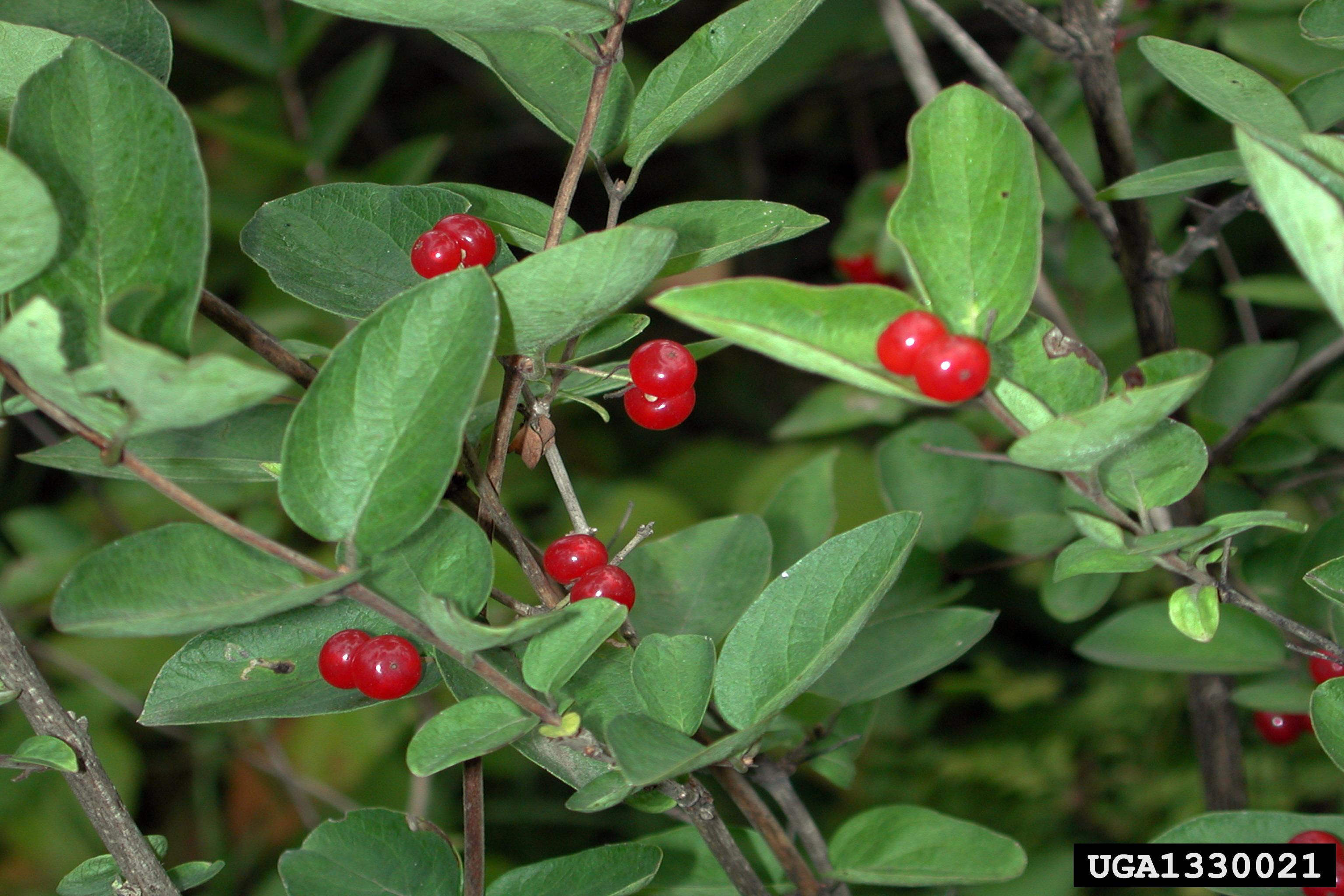In this article, we look at a trio of invasive plants that are known collectively as “Eurasian bush honeysuckles.” Although there are bush honeysuckles native to North America, these non-native species can out-compete many native plant species. They are found throughout Maryland and the mid-Atlantic states, where these multi-stemmed plants spread rapidly in disturbed areas, forming dense thickets that can reach ten to fifteen feet in height.
What are they?
As many as seven non-native species have been found in the mid-Atlantic states. The three that are the most common were introduced as ornamental plants in the 1800s: Amur (Lonicera maackii), from China; Morrow’s (Lonicera morrowii), from Japan; and Tatarian (Lonicera tatarica), from Russia. They were also planted for wildlife food and cover and for erosion control as recently as the 1970s. Since that time, the species have colonized areas as far west as California and as far south as Georgia and Texas, where they compete for space, light and nutrients with both native trees and wildflowers. They are most often found in hedgerows, forest edges, forested floodplains and other disturbed areas with moderate to high light levels. Because they bloom earlier than native species, they may shade out native ephemeral species. Additionally, some studies suggest that bush honeysuckles may produce a toxin that inhibits the growth of competitors.

How do they spread?
Bush honeysuckles spread primarily by seed. Their distribution is aided by birds, which eat the fruit and disperse the seeds through their droppings.
How can I identify them?
The various species may be difficult to distinguish in the field, but they can be readily distinguished from native honeysuckles. Native honeysuckles are stout, erect shrubs that prefer dry or rocky sites. The non-native species prefer moister soils. Native honeysuckles have yellow flowers; the invasives’ flowers come in a variety of colors. Each of the invasives have oblong to oval leaves that grow in an opposite arrangement on the stem. See the Image Gallery below.
How can I control them?
If you have a small infestation of Eurasian bush honeysuckles, they can be removed easily by hand because of their shallow root system. Be sure to collect the berries and seeds if present to prevent further spread. However, invasive bush honeysuckles should not be mowed, as cutting them down does not kill the plant and may encourage further growth to sprout from the roots left behind.
Larger infestations will require a combination of cutting and herbicide application. Cutting them in early spring and late fall for several years will eventually kill the plants by reducing their reserve nutrients. Applying a glyphosate herbicide to the leaves or to the freshly-cut stump late in the growing season is an effective means of killing existing plants. Removal should be accompanied by planting native species to discourage further growth of the invasive plants.
For more information:
Learn more about Eurasian bush honeysuckles:
Invader of the Month (Maryland Invasive Species Council)
Invasive Species Highlight: Bush Honeysuckles… Not for the Birds! (Penn State University)
Eurasian Bush Honeysuckle (Forest Invasive Plants Resource Center)
 English
English العربية
العربية Български
Български 简体中文
简体中文 繁體中文
繁體中文 Hrvatski
Hrvatski Čeština
Čeština Dansk
Dansk Nederlands
Nederlands Suomi
Suomi Français
Français Deutsch
Deutsch Ελληνικά
Ελληνικά हिन्दी
हिन्दी Italiano
Italiano 日本語
日本語 한국어
한국어 Norsk bokmål
Norsk bokmål Polski
Polski Português
Português Română
Română Русский
Русский Español
Español Svenska
Svenska Català
Català Filipino
Filipino עִבְרִית
עִבְרִית Bahasa Indonesia
Bahasa Indonesia Latviešu valoda
Latviešu valoda Lietuvių kalba
Lietuvių kalba Српски језик
Српски језик Slovenčina
Slovenčina Slovenščina
Slovenščina Українська
Українська Tiếng Việt
Tiếng Việt Shqip
Shqip Eesti
Eesti Galego
Galego Magyar
Magyar Maltese
Maltese ไทย
ไทย Türkçe
Türkçe فارسی
فارسی Afrikaans
Afrikaans Bahasa Melayu
Bahasa Melayu Kiswahili
Kiswahili Gaeilge
Gaeilge Cymraeg
Cymraeg Беларуская мова
Беларуская мова Íslenska
Íslenska Македонски јазик
Македонски јазик יידיש
יידיש Հայերեն
Հայերեն Azərbaycan dili
Azərbaycan dili Euskara
Euskara ქართული
ქართული Kreyol ayisyen
Kreyol ayisyen اردو
اردو বাংলা
বাংলা Bosanski
Bosanski Cebuano
Cebuano Esperanto
Esperanto ગુજરાતી
ગુજરાતી Harshen Hausa
Harshen Hausa Hmong
Hmong Igbo
Igbo Basa Jawa
Basa Jawa ಕನ್ನಡ
ಕನ್ನಡ ភាសាខ្មែរ
ភាសាខ្មែរ ພາສາລາວ
ພາສາລາວ Latin
Latin Te Reo Māori
Te Reo Māori मराठी
मराठी Монгол
Монгол नेपाली
नेपाली ਪੰਜਾਬੀ
ਪੰਜਾਬੀ Afsoomaali
Afsoomaali தமிழ்
தமிழ் తెలుగు
తెలుగు Yorùbá
Yorùbá Zulu
Zulu ဗမာစာ
ဗမာစာ Chichewa
Chichewa Қазақ тілі
Қазақ тілі Malagasy
Malagasy മലയാളം
മലയാളം සිංහල
සිංහල Sesotho
Sesotho Basa Sunda
Basa Sunda Тоҷикӣ
Тоҷикӣ O‘zbekcha
O‘zbekcha አማርኛ
አማርኛ Corsu
Corsu Ōlelo Hawaiʻi
Ōlelo Hawaiʻi كوردی
كوردی Кыргызча
Кыргызча Lëtzebuergesch
Lëtzebuergesch پښتو
پښتو Samoan
Samoan Gàidhlig
Gàidhlig Shona
Shona سنڌي
سنڌي Frysk
Frysk isiXhosa
isiXhosa